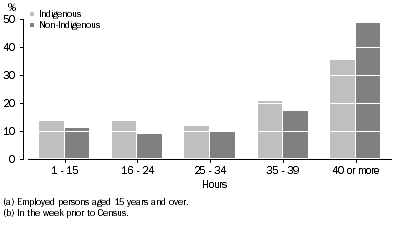EMPLOYMENT
In the 2006 Census, 46% of Indigenous people aged 15 years and over were employed (employment to population ratio), compared with 42% in the 2001 Census. A higher proportion of men (51%) were employed than women (41%).
Non-Indigenous people were more likely than Indigenous people to be employed. In the 2006 Census, with 62% of non-Indigenous people aged 15 years and over employed, compared with 59% in 2001.
The proportion of Indigenous people employed was higher in Major Cities (50%) than in other geographic areas (Very Remote 45%, Inner Regional 44%, Remote 44%, Outer Regional 44%).
Employed people
Of Indigenous people who were employed in the 2006 Census:
- 93% were employees, 6% worked in their own business and 1% were contributing family workers
- 74% were employed in the private sector, and one quarter (26%) worked in the public sector
- over half (57%) worked full-time, 39% worked part-time hours and 4% did not work in the week prior to the Census
- more than half (59%) worked in low skill occupations, while one in five (22%) were in medium skill occupations and one in seven (15%) in high skill occupations
- 33% who were employed and not also attending school had completed Year 10 and 31% had completed Year 12
- more than one-third (37%) reported having a non-school qualification.
Worked in own business
In 2006, 6,800 or 6% of employed Indigenous people indicated they worked in their own business. This compares with 17% of employed non-Indigenous people. The proportion of employed Indigenous people who worked in their own business was highest in Major Cities (7%) and lowest in Very Remote areas (2%). In contrast, the proportion of employed non-Indigenous people who worked in their own business was similar across remoteness areas.
Worked in own business by remoteness areas(a)(b)

Hours worked
Employed Indigenous people were more likely than employed non-Indigenous people to have worked part-time hours in the week prior to the 2006 Census (39% and 30% respectively). Both Indigenous and non-Indigenous women were more likely to have worked part time hours (49% and 45% respectively), than Indigenous and non-Indigenous men (31% and 17%).
Over one-third (36%) of employed Indigenous people worked 40 or more hours in the week prior to Census, compared with almost half (49%) of non-Indigenous people. In the reference week, 57% of Indigenous people worked full-time hours, with males (66%) more likely than females (46%) to work full-time hours. In comparison, 66% of non-Indigenous people worked full-time hours in the same week. Again, males (79%) were more likely than females (51%) to work full-time hours.
Hours Worked(a)(b)

 Print Page
Print Page
 Print All
Print All